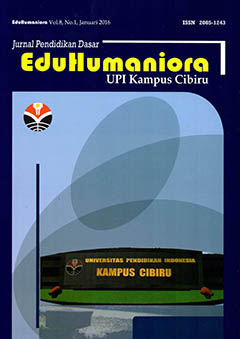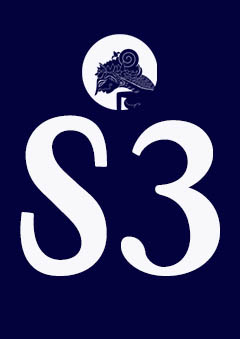PERCEPTION OF ELEMENTARY SCHOOL TEACHERS AND STUDENTS ON DIGITAL AUGMENTED REALITY LEARNING MEDIA
Abstract
Keywords
Full Text:
PDFReferences
Agustina, N., & Susanto, R. (2017). Persepsi Guru Terhadap Pengembangan Profesionalisme Melalui Pelatihan Media Pembelajaran Berbasis Edmodo. Jl. Udayana Kampus Tengah, 0362, 27213. http://pti.undiksha.ac.id/senapati
Alkhattabi, M. (2017). Augmented reality as e-learning tool in primary schools’ education: Barriers to teachers’ adoption. International Journal of Emerging Technologies in Learning, 12(2), 91–100. https://doi.org/10.3991/ijet. v12i02.6158
Amin, D., & Govilkar, S. (2015). Comparative Study of Augmented Reality Sdk’s. International Journal on Computational Science & Applications, 5(1), 11–26. https://doi.org/10.5121/ijcsa.2015.5102
Anggianita, S., Yusnira, Y., & Rizal, M. S. (2020). Persepsi Guru terhadap Pembelajaran Daring di Sekolah Dasar Negeri 013 Kumantan. Journal of Education Research, 1(2), 177–182. https://doi.org/10.37985/joe.v1i2.18
Bell, B., Feiner, S., & Höllerer, T. (2001). View management for virtual and augmented reality. UIST (User Interface Software and Technology): Proceedings of the ACM Symposium, 3(2), 101–110. https://doi.org/10.1145/502360.502363
Billinghurst, M., Clark, A., & Lee, G. (2014). A survey of augmented reality. Foundations and Trends in Human-Computer Interaction, 8(2–3), 73–272. https://doi.org/10.1561/1100000049
Bimber, O., & Raskar, R. (2006). Modern approaches to augmented reality. SIGGRAPH 2006 - ACM SIGGRAPH 2006 Courses. https://doi.org/10.1145/1185657.1185796
Chen, Y., Wang, Q., Chen, H., Song, X., Tang, H., & Tian, M. (2019). An overview of augmented reality technology. Journal of Physics: Conference Series, 1237(2). https://doi.org/10.1088/1742-6596/1237/2/022082
Dünser, A., Grasset, R., & Billinghurst, M. (2008). Survey of Evaluation Techniques Used in Augmented Studies. ACM SIGGRAPH ASIA 2008 Courses, SIGGRAPH Asia’08, January. https://doi.org/10.1145/1508044.1508049
Elmqaddem, N. (2019). Augmented Reality and Virtual Reality in education. Myth or reality? International Journal of Emerging Technologies in Learning, 14(3), 234–242. https://doi.org/10.3991/ijet.v14i03.9289
Friedrich, W. (2002). ARVIKA-augmented reality for development, production and service. Proceedings - International Symposium on Mixed and Augmented Reality, ISMAR 2002, 3–4. https://doi.org/10.1109/ISMAR.2002.1115059
Gershon, A. A. (2001). The current status of live attenuated varicella vaccine. Archives of Virology, Supplement, 17, 1–6. https://doi.org/10.1007/978-3-7091-6259-0_1
Karaarslan, S. V. (2018). Application of augmented reality technologies in archaeology. English Article, 2018, 181–200. http://www.arkeotekno.com/pg_305_application-of-augmented-reality-technologies-in-archaeology
Litts, B. K., & Lewis, W. E. (2019). Mobile Augmented Reality. GetMobile: Mobile Computing and Communications, 22(3), 5–9. https://doi.org/10.1145/3308755.3308757
Midak, L. Y., Kravets, I. V., Kuzyshyn, O. V., Berladyniuk, K. V., Buzhdyhan, K. V., Baziuk, L. V., & Uchitel, A. D. (2020). Augmented reality in process of studying astronomic concepts in primary school. CEUR Workshop Proceedings, 2731(March), 239–250.
Molnár, G., Szűts, Z., & Biró, K. (2018). Use of augmented reality in learning. Acta Polytechnica Hungarica, 15(5), 209–222. https://doi.org/10.12700/APH.15.5.2018.5.12
Rekimoto, J., & Ayatsuka, Y. (2000). CyberCode: Designing augmented reality environments with visual tags. Proceedings of DARE 2000 on Designing Augmented Reality Environments, 1–10. https://doi.org/10.1145/354666.354667
Saurina, N. (2016). Pengembangan Media Pembelajaran Untuk Anak Usia Dini Menggunakan Augmented Reality. Jurnal IPTEK, 20(1), 95. https://doi.org/10.31284/j.iptek.2016.v20i1.27
Suhandi Saputra, D., Vebrianto Susilo, S., Mulyawati, T., Abidin, Y., & Rachmadtullah, R. (2020). The Development of Indonesian Language Learning Media Based on Augmented Reality For Fifth Grade of Elementary School. International Journal of Advanced Science and Technology, 29(5), 12581–12588.
Suharso, A. (2012). Solusi, Vol. 11 No. 24 Edisi September-Nopember 2012 MODEL PEMBELAJARAN INTERAKTIF BANGUN RUANG 3D BERBASIS AUGMENTED REALITY Oleh : Aries Suharso. Model Pembelajaran Interaktif Bangun Ruang 3D Berbasis Augmented Reality, 11(24), 1–11.
Usada, E. (2018). Pemanfaatan Augmented Reality (AR) sebagai Prototype Media Belajar Pendukung dalam Praktikum Penyambungan Serat Optik. Jurnal Komunika : Jurnal Komunikasi, Media Dan Informatika, 7(1). https://doi.org/10.31504/komunika.v7i1.1221
Van Krevelen, D. W. F., & Poelman, R. (2010). A Survey of Augmented Reality Technologies, Applications and Limitations. International Journal of Virtual Reality, 9(2), 1–20. https://doi.org/10.20870/ijvr.2010.9.2.2767
Wagner, D., & Schmalstieg, D. (2003). First steps towards handheld augmented reality. Proceedings - International Symposium on Wearable Computers, ISWC, 127–137. https://doi.org/10.1109/iswc.2003.1241402
Williams, J. C., & Lebsock, S. (2019). The Definitive Management Ideas of the Year from Harvard Business Review. In Harvard Business Review. www.hbr.org
Yuen, S. C.-Y., Yaoyuneyong, G., & Johnson, E. (2011). Augmented Reality: An Overview and Five Directions for AR in Education. Journal of Educational Technology Development and Exchange, 4(1). https://doi.org/10.18785/jetde.0401.10
DOI: https://doi.org/10.17509/eh.v14i1.40053
Refbacks
- There are currently no refbacks.
Copyright (c) 2022 EduHumaniora | Jurnal Pendidikan Dasar Kampus Cibiru
EduHumaniora: Jurnal Pendidikan Dasar
Published in collaboration Program Studi PGSD UPI Kampus Cibiru
and
HDPGSDI
This work is licensed under a Creative Commons Attribution-ShareAlike 4.0 International License.















